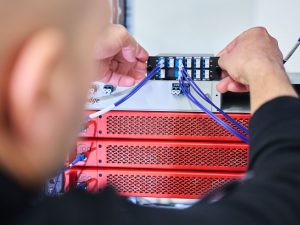The day that quantum computers will be able to break the current encryption standards is coming closer. Approximately 10 years from now, our information will not be secure if we do not encrypt it in a quantum-proof way. Quantum communication tackles this challenge and revolutionises secure information exchange. For one year now, the University of Luxembourg’s Interdisciplinary Centre for Security, Reliability, and Trust (SnT) has demonstrated quantum key distribution (QKD) at a distance of 33 km between the Kirchberg and Belval Campuses in Luxembourg.
To introduce secure information exchange, researchers from SnT have built this national testbed for quantum communication called the Luxembourg Quantum Communication Infrastructure Laboratory (LUQCIA). This project is funded by the European Union – Next Generation EU, in collaboration with the Department of Media, Connectivity and Digital Policy of the Luxembourgish Government under the framework of the Recovery and Resilience Facility (RRF) programme. And since 2023, SnT’s researchers have demonstrated quantum-proof exchange of information continuously and daily.
One year ago, in August 2023, SnT’s Signal Processing and Communications (SIGCOM) research group completed all connections and ran the demonstration between Kirchberg and Beval Campus for the first time. After that, our researchers started monitoring the connection and collected data for one year. During this year, SnT’s researchers have been observing the key performance indicators of the link and analysing their behaviour in a real-life scenario. They also assessed whether the link can be operated continuously.
“Now, after one year of exchanging quantum keys in Luxembourg, we have experienced how this technology works outside the laboratories. For the connection, we used commercial QKD devices and real optical fibers. Maintaining the flow of information in real-life circumstances is fundamental for putting this technology into practice in the future,” said Dr. Jorge Luis Gonzalez Rios, technical coordinator of the Quantum Communication Infrastructure (QCI) Lab.
The performance of keys exchanged under real-life conditions showed almost the same results as those tested in the laboratory under emulated conditions. However, the researchers found that the performance on the SnT national testbed showed variations that cannot be replicated in the lab.
“For example, when cars drive down the road, this generates vibrations that do not affect classical communication, but can put mechanical stress on the quantum communication link below the street. We found that when the working day starts at 8 am and in the evening, there are changes in the performance of our demonstration. The number of exchanged keys varies due to external effects. We are currently looking into the reasons for these drops; the traffic on the road above our testbed or temperature fluctuations could be possible reasons,” explained Dr. Gonzalez Rios.
For SnT’s team, it was a challenge to keep the demonstration alive for one year and to continuously exchange keys. On some occasions, the team has completely lost communication. For such scenarios, it is important to prepare for the future. SnT’s researcher work on a buffer to securely store secret keys for the time before and after the exchange, at least for a short time. In this way, Luxembourg will be prepared for communication shortages in the future.
“Other challenges were to establish the link itself, but also to use at least one fiber that is purely dedicated to the quantum channel. Due to the physical law behind quantum communication, we couldn’t use active devices like amplifiers, which are typically used to extend classical communication, to prolong the distance of the demonstration,” shared Dr. Gonzalez Rios.
Quantum communication is based on complex physical laws, which allows communicating parties to exchange secret keys in a quantum-proof way. Using so-called quantum bits (qubits), this kind of exchange is much safer compared to the one currently in use, because any interventions of a third party trying to read or measure the keys will affect the key itself. Due to physical law, the bits will then be destroyed, and interferences will appear. The infrastructure to exchange the keys is made of distribution nodes, connected with fibre optic, a material that transmits the quantum bits.
“We are very proud to have reached this milestone: One year of operating our demonstration under real-life conditions. We have successfully built our infrastructure and proved that quantum-proof communication is not far away. Our vision is to support Luxembourg’s quantum communication and cybersecurity stakeholders, especially in industry. This will bring our infrastructure even closer to practice,” said Dr. Gonzalez Rios.
The SnT team plans the next steps for their demonstration: Soon, after keeping the connection alive for one year, SnT plans to interconnect it with similar national and European initiatives, such as the Lux4QCI network and the upcoming cross-border connection with the Belgian BeQCI. LUX4QCI aims to deliver the first experimental quantum communication infrastructure network in Luxembourg with industry partners and paves the way for future links to other national quantum communication infrastructures, a key part of the EuroQCI initiative. Looking to the future, the SnT researchers aim to also interconnect the national testbed (LUQCIA) with a space-based quantum key distribution system on satellites called EAGLE-1, developed by ESA, the European Commission, and space companies in Europe.
